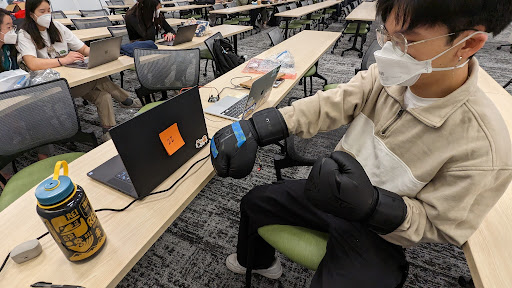Apr 2023 - Jun 2023
Cory Hyunh
Marty Acevedo
Researcher
Product Designer
User Tester
Marty Acevedo, a former dietitian with Parkinson’s Disease, manages her symptoms through exercise and cognitive stimulation with games like Wordle. We aimed to design a fun and easy way for people like Marty, our stakeholder, to get daily cognitive stimulation and exercise. This led to the creation of Odd-Even Boxing, a game combining math with boxing, using gloves equipped with MPU6050 accelerometers to detect punches and control the game. I was the lead designer of the game and product and led hardware efforts.
Patients with Parkinson’s Disease experience symptoms like tremors, slowed movements, rigid muscles, and loss of automatic movements (Mayo Clinic). Marty Acevedo, a Parkinson’s patient and advocate for 8 years, emphasized the benefits of aerobic exercise and boxing for symptom improvement and disease progression. She also mentions cognitive games like Wordle also play a role in managing symptoms.
In our project, we aimed to merge boxing with cognitive video games to encourage exercise for patients. The objective was to create a game that stimulates both body and mind, making workouts interactive and fun. Using accelerometers (devices that track motion) in boxing gloves, punches control gameplay intensity and type, working similarly to a Wii. As the design lead, I drew inspiration from Brain Academy for our cognitive game, striking a balance between challenge and accessibility to maintain engagement.
To start, I began by sketching various game concepts for our cognitive boxing video game. I adhered to criteria established by our team and Marty:
The game should be challenging yet enjoyable, avoiding frustration.
Players should have the option to select their preferred difficulty level.
The game should promote exercise through multiple rounds of punches.
It should be safe for players, ideally playable while seated or standing still.
Compliance with our hardware limitations is essential.
From the criteria, I developed three game concepts. The first involved solving math equations by punching corresponding numbers in a timed challenge. Another concept merged rhythmic punching with colored circles, inspired by rhythmic games.
Ultimately, we chose a math game where players determine if equations are even or odd while hooking enemies for bonus points. Paper prototypes confirmed that it was a fun and effective workout, though counting items rather than solving equations caused confusion and was subsequently removed from the game.
We planned and configured our game by connecting two accelerometers to a breadboard and then to an Arduino, providing inputs to a Unity game. After testing and integrating the accelerometers, we adjusted the code to recognize punch thresholds as keyboard inputs ('a' for left, 'b' for right). Using a breadboard allowed both accelerometers to connect to a single Arduino for independent punch interpretation. Finally, I integrated the hardware into boxing gloves, ensuring ample wire length for ease of gameplay.
For a more human-focused evaluation, we first tested with Marty, roommates, and friends. We introduced the game briefly and let them play, then gathered feedback through a series of questions. Based on their input, we iterated and improved the game. Input included:
Marty was extremely positive about our game, believing it worked well for Parkinson’s patients.
The software had no bugs and did not crash.
Punch accuracy and responsiveness were good, though it occasionally detected false punches.
The “Combo” system was confusing as it was thought to be meant as punch combos rather than player streak.
The timer seemed too rushed, especially on harder difficulties.
Suggestion to add even harder levels for more challenge.
Recommendations for better indications for correct and incorrect answers.
The streak system was perceived as unbalanced, scoring too many points.
We were able to implement these changes into the final design of our project. To see how our game ran, watch this demo video:
Though our project was successful, we wished we had researched our hardware capabilities earlier, which limited our implementation of varied punches like hooks and uppercuts. With more time, we would have integrated Bluetooth and vibration motors to enhance the design, avoid tangled wires, and perform more testing. Overall, working with Marty was rewarding, and we developed a product we are proud of.


